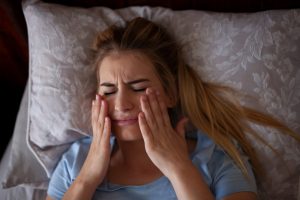Tackling the rising tide of bruxism
Featured Products Promotional FeaturesPosted by: Dental Design 30th September 2023

Bruxism is a far more prevalent issue than most people realise, impacting an estimated 80% of the population at some point in their lives. The impact can be serious and far-reaching, with the potential to influence every aspect of a sufferer’s life. Being able to provide these patients with relief from the pain and discomfort caused is essential for every single general dental practitioner (GDP) and their team.
Why so high?
Incidence of bruxism is believed to have risen in recent years. Bruxism has many different causes, which include stress and anxiety, lifestyle factors and sleep disorders – the former is the most common.[i] Sadly, one in 14 adults in the UK feel stressed every single day, while one in 5 feel stressed more days than they feel fine every month. A massive 79% of people report feeling stressed at least once a month in the UK, with people suffering for an average of just over 8 days each month.[ii] Among the key reasons for such anxiety levels are lack of sleep and money worries, work and workload demands. The additional challenges brought on by the pandemic no doubt added to the stressors that many people regularly face too.
Unfortunately, higher stress could mean unhealthier lifestyle choices, which in turn can further exacerbate the risk of bruxism. For instance, stress is linked with an increase in smoking[iii] and alcohol consumption,[iv] both of which are co-factors of bruxism.[v] Just like other psychoactive substances like caffeine or certain medications, these can lead to problems sleeping – which is another risk factor for bruxism.
In fact, any sleep disorder can increase the chance of bruxism occurring, with obstructive sleep apnoea (OSA) remaining the highest risk factor. Any apnoea event is often accompanied by mouth movements
such as snoring gasping, mumbling and tooth grinding.v
Given the close links between all of these risk factors for bruxism, combined with the increasing stressors that we face in everyday life today, it’s no wonder that the condition impacts so many people.
The impact of bruxism
 There is a myriad of both short- and long-term impacts from bruxism. The immediate and usually temporary symptoms include headaches, facial myalgia, earache, tightness of the shoulders, sleep disruption, excess tooth mobility and inflamed or receding gums. Longer-term and sadly even potentially permanent adverse effects include temporomandibular joint disorders (TMDs) and tooth wear or breakage.v
There is a myriad of both short- and long-term impacts from bruxism. The immediate and usually temporary symptoms include headaches, facial myalgia, earache, tightness of the shoulders, sleep disruption, excess tooth mobility and inflamed or receding gums. Longer-term and sadly even potentially permanent adverse effects include temporomandibular joint disorders (TMDs) and tooth wear or breakage.v
Add to all of these symptoms the on-going lack of sleep and pain that can come from excessively grinding the teeth or clenching the jaw, and it is little wonder that bruxism has such a huge impact on patients. Studies have demonstrated that oral health-related quality of life significantly reduced,[vi] and that’s not to mention the financial or emotional cost of repeatedly restoring broken or mobile teeth.
Unfortunately, treating bruxism can be difficult and may require a multidisciplinary approach involving several healthcare professionals to help a patient tackle the causes. However, dental professionals can provide substantial relief for sufferers through the provision of splints or night guards.
Not all night guards are made equal
 Where appropriate, occlusal splints or night guards may offer a solution to protect the patient’s teeth from further tooth wear or fractures. However, not all are made equal in quality, convenience or cost-effectiveness.
Where appropriate, occlusal splints or night guards may offer a solution to protect the patient’s teeth from further tooth wear or fractures. However, not all are made equal in quality, convenience or cost-effectiveness.
In many cases, splints fabricated in the dental lab can be expensive for the patient and this level of engineering may not be necessary. Chairside options often provide a more cost-efficient and faster solution that patients appreciate – such as the SOVA® night guard from Oraldent.
This remouldable, pre-formed device is easy to fit with a simple professional workflow and no need for any impressions. The innovative Diffusix™ Technology ensures even distribution and absorption of forces, while the biocompatible material features no BVA, PVC, latex or phthalate. Patients will also appreciate the super thin 1.6mm inside wall that optimises comfort while also ensuring that speaking, drinking and sleeping are easy. What’s more, SOVA has been proven to be an inexpensive and effective alternative to traditional gold standard splints.[vii]
Be prepared
Given the high prevalence of bruxism among the general population, all GDPs are likely to come across patients in need of support for its symptoms. As a destructive and life debilitating condition, being able to alleviate the impact of bruxism on a patient’s quality of life is essential. Finding easy to implement and affordable solutions that enable you to deliver customised protective devices is an excellent start.

For more details, please visit Oraldent.co.uk/bruxism or call 01480 862080
Bio – Julia Svec
Julia Svec is the Product Development Manager for Billion Dollar Smile Cosmetics Ltd. She has spent the last ten years working in collaboration with dentists, laboratories and manufacturers in North America, Europe and Asia researching and developing effective and safe non-peroxide teeth-whitening products for professional and home use.
[i] NHS. Teeth grinding (bruxism). https://www.nhs.uk/conditions/teeth-grinding/ [Accessed May 2023]
[ii] CIPHR. Workplace stress statistics in the UK. https://www.ciphr.com/workplace-stress-statistics/ [Accessed May 2023]
[iii] Lawless MH, Harrison KA, Grandits GA, Eberly LE, Allen SS. Perceived stress and smoking-related behaviors and symptomatology in male and female smokers. Addict Behav. 2015 Dec;51:80-3. doi: 10.1016/j.addbeh.2015.07.011. Epub 2015 Jul 26. PMID: 26240941; PMCID: PMC4558262.
[iv] Noah R. Wolkowicz, MacKenzie R. Peltier, Stephanie Wemm, R. Ross MacLean,
Subjective stress and alcohol use among young adult and adult drinkers: Systematic review of studies using Intensive Longitudinal Designs, Drug and Alcohol Dependence Reports. 2022; 3; 100039, ISSN 2772-7246 https://doi.org/10.1016/j.dadr.2022.100039.
[v] The Bruxism Association/ Causes of Bruxism. http://www.bruxism.org.uk/causes-of-bruxism.php [Accessed May 2023]
[vi] Turcio KH, Neto CM, Pirovani BO, Dos Santos DM, Guiotti AM, Bertoz AM, Brandini DA. Relationship of bruxism with oral health-related quality of life and facial muscle pain in dentate individuals. J Clin Exp Dent. 2022 May 1;14(5):e385-e389. doi: 10.4317/jced.59255. PMID: 35582352; PMCID: PMC9094727.
[vii] Gerstner G, Yao W, Ludkin D, Sinacola R, Frimenko K. A comparison of compliance and oral health between two bite splints, a randomized clinical trial. Clinical research. Manuscript number JPD_2018_27.








